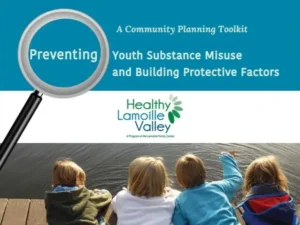About Prevention
Prevention improves lives, strengthens communities and saves money. Prevention promotes healthy behaviors and discourages unhealthy behaviors.
Substance misuse prevention initiatives create environments that:
- support healthy behaviors;
- build healthy community norms by using evidence-based, comprehensive strategies; and
- reduce alcohol, tobacco. marijuana or other drug misuse.
Prevention strategies are most likely to succeed if they reach people in multiple settings – state, community, school, work, family, and individual environments.

Featured Resource

We Can Prevent Substance Misuse
Scientists have developed a broad range of programs that positively alter the balance between risk & protective factors for drug use in families, schools and communities. Research proves that prevention efforts can significantly reduce early use of tobacco, alcohol and other drugs. AND while many social and cultural factors promote drug use, when young people perceive drug use as harmful, substance use rates decrease.

Nature & Nurture
Alcohol and drug abuse can happen to ANYONE, but the more risk vs protective factors someone has, the more likely that they’ll struggle with Substance Misuse Disorder. That’s why prevention is not just about saying no or limiting access to drugs and alcohol, but also about increasing protective factors and decreasing risk factors.
Who does Prevention?
Everyone can.
Prevention is a multi-generational, team effort. Parents and caregivers may be especially interested in learning about prevention since alcohol and drug use by youth is strongly related to future substance abuse & addiction. Strong community collaboration is crucial to successful prevention initiatives.
Coalitions Lead the Way
In Vermont, community coalitions work in more than 200 communities with many partners to implement substance misuse prevention strategies. These strategies aim to change community norms and standards of conduct related to substance misuse in the community. We know that communities with coalitions have lower youth drug use rates than communities without a coalition.
Healthy Individuals
More and more, drug and alcohol misuse issues are seen as inextricable from other problems like poverty, physical health, abuse and neglect, and environmental conservation. We have learned that when individuals have access to health and life affirming goods and services, we all benefit.
Start Early
More and more, drug and alcohol misuse issues are seen as inextricable from other problems like poverty, physical health, abuse and neglect, and environmental conservation. We have learned that when individuals have access to health and life affirming goods and services, we all benefit.
Why Spend Public Funds on Prevention?
Because the benefits of prevention outweigh the costs.
By stopping substance use before it starts, or before it becomes substance misuse or abuse, prevention also works to save Vermont tax dollars.
Evidence-based school prevention programs can save Vermont $18 for every $1 invested.
For every $1 invested in evidence-based programs that support strong family connections, combined with school prevention, Vermont can save between $3 and $11.
The positive outcomes from successful substance misuse prevention include:
- Fewer drug abuse-related emergency room visits
- Increased productivity
- Improved job stability
- Fewer unemployment episodes,
- Lower rates of violent crime,
- Prevention of DUI injuries to others
- Better family interaction
- Reduced juvenile delinquency
- Fewer incidents of family violence
- Improved school attendance and academic achievement, and
- Better health outcomes
Source: CASAColumbia. (2009). Shoveling up II: The Impact of Substance Abuse on Federal, State and Local Budgets.
When do we start?
ANYTIME. And the earlier the better, because:
- Youth are five times more likely to develop a substance use disorder compared to adults. Only about 10% of substance dependence cases occur in people who began using after adolescence.
- People who began using addictive substances before age 15 are 6 1/2 times more likely to become addicted than those who delay first use until age 21 or older.
- 9 out of 10 people with addiction involving addictive substances began using before the age of 18.
- Every year that substance use is delayed during brain development. the risk of addiction decreases.
(Source: CASA Columbia. (2011). Adolescent substance use: America’s #1 Public Health Problem.)
Drug Prevention Tips for Every Age – from age 2 to 25 When tackling some of life’s tougher topics with youth, especially those about alcohol and other drugs, figuring out what to say can be a challenge. Click here to read scenarios and scripts for ideas of what to say to the young people you care about.
Can We Prevent Substance Misuse in Vermont?
Yes, we can and we have!
When funding is dedicated to prevention efforts we see substance misuse rates decrease.
Science-validated substance misuse prevention programs, if properly implemented by schools and communities, can reduce substance abuse.
Also demonstrating success are environmental strategies – those prevention efforts aimed at changing or influencing community conditions, standards, systems and policies.
